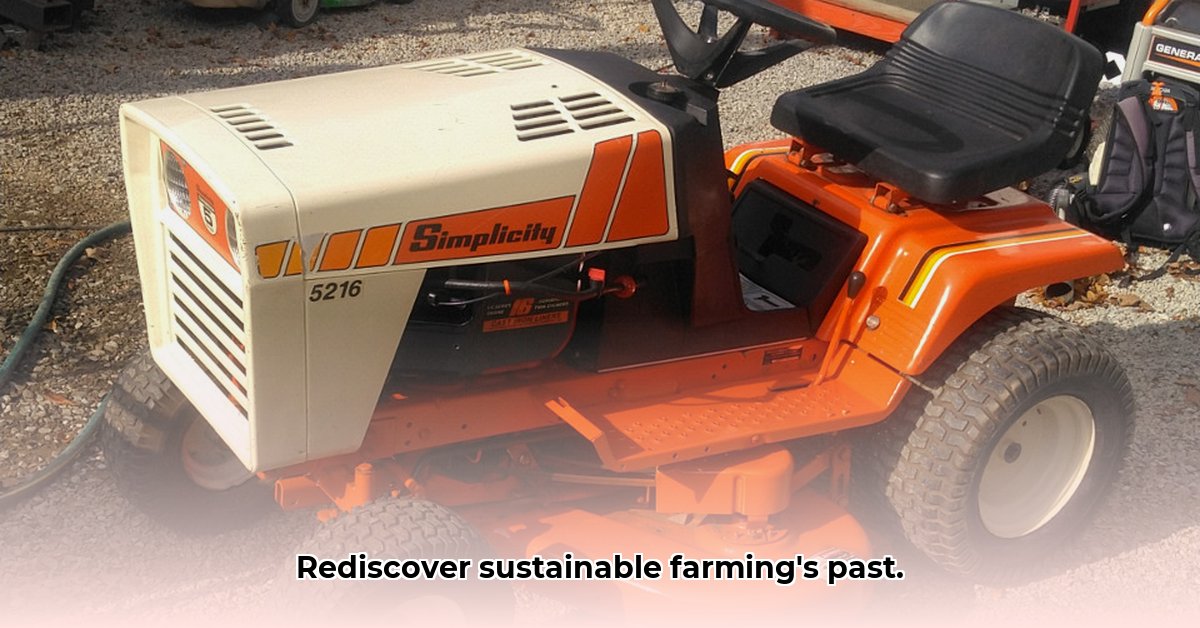
The hum of a Simplicity lawn tractor, a familiar sound on countless suburban lawns, belies a rich history interwoven with the broader narrative of agricultural equipment consolidation and its evolving relationship with sustainability. This article examines the 1986 Simplicity model, not just as a piece of machinery, but as a data point within a larger economic and environmental story. For more on early Simplicity models, see this 1970s Simplicity Tractors.
Simplicity's Humble Beginnings and Steady Growth
Simplicity Manufacturing's journey began in 1937, not with ambitious visions of global dominance, but with a straightforward goal: crafting reliable, affordable lawnmowers. This focus on dependable quality, combined with the post-war economic boom and suburban expansion, fueled their initial success. The burgeoning American dream, often visualized as a perfectly manicured lawn, found a crucial partner in Simplicity. This focus on dependability would become a core element of their brand identity.
The 1986 Model: A Workhorse of its Era
The 1986 Simplicity lawn tractor embodies this commitment to dependability. Though precise specifications are limited, its design prioritized durability and ease of use. While not technologically revolutionary, it was a reliable workhorse, efficiently tending to lawns across the nation. Its success highlights the enduring importance of robust engineering and user-friendliness, even amid rapid technological advancements. Was this inherent durability, however, a contributor to sustainability by reducing the need for frequent replacements? This remains an area requiring additional investigation.
Navigating a Competitive Landscape: Simplicity in the 1980s
The 1980s agricultural equipment market was a dynamic arena dominated by giants like John Deere and Case IH. However, smaller players like Simplicity flourished by carving out distinct niches. Simplicity targeted homeowners and smaller operations, providing dependable, user-friendly machines. This strategic focus allowed them to thrive amidst intense competition. This success begs the question: How did this focused strategy contribute to or detract from broader environmental sustainability goals within agricultural practices?
Consolidation and Acquisition: A Shifting Industry Landscape
The agricultural equipment industry is characterized by periods of intense consolidation. Simplicity's history reflects this trend. Initially an independent entity, Simplicity was acquired by Allis-Chalmers in 1965, a move indicative of the emerging industry consolidation pattern. A brief period of independence followed a 1983 management buyout, only to be followed by acquisition by Briggs & Stratton in 2004, highlighting the powerful forces shaping the market. Did these mergers and acquisitions ultimately benefit or hinder efforts toward sustainable agricultural practices? Further research is needed to fully address this question.
Sustainability: A Complex Interplay
Assessing the 1986 Simplicity tractor's contribution to sustainable agriculture requires a nuanced approach. Its durability suggests a longer lifespan than many disposable products, arguably reducing waste. However, a thorough environmental impact assessment necessitates a deeper look into manufacturing processes, materials used, and fuel efficiency data, which remains largely unavailable. The complexities of industry consolidation on sustainability are equally intricate. Larger entities could potentially advance sustainable practices through economies of scale, but reduced competition might also stifle innovation in eco-friendly technologies.
Conclusion: Simplicity's Enduring Legacy
The 1986 Simplicity lawn tractor, and indeed the company's entire history, provides a valuable microcosm of the agricultural equipment industry's evolution. It illustrates the ongoing tension between independent innovation and the pressures of corporate consolidation. Simplicity’s legacy transcends individual machines; it reflects broader economic and technological shifts. While comprehensive data on their long-term environmental impact is still unavailable, the 1986 model serves as a vital research topic for understanding this complex interplay between agricultural innovation and sustainability. Further research is needed to determine the full scope of their contribution.